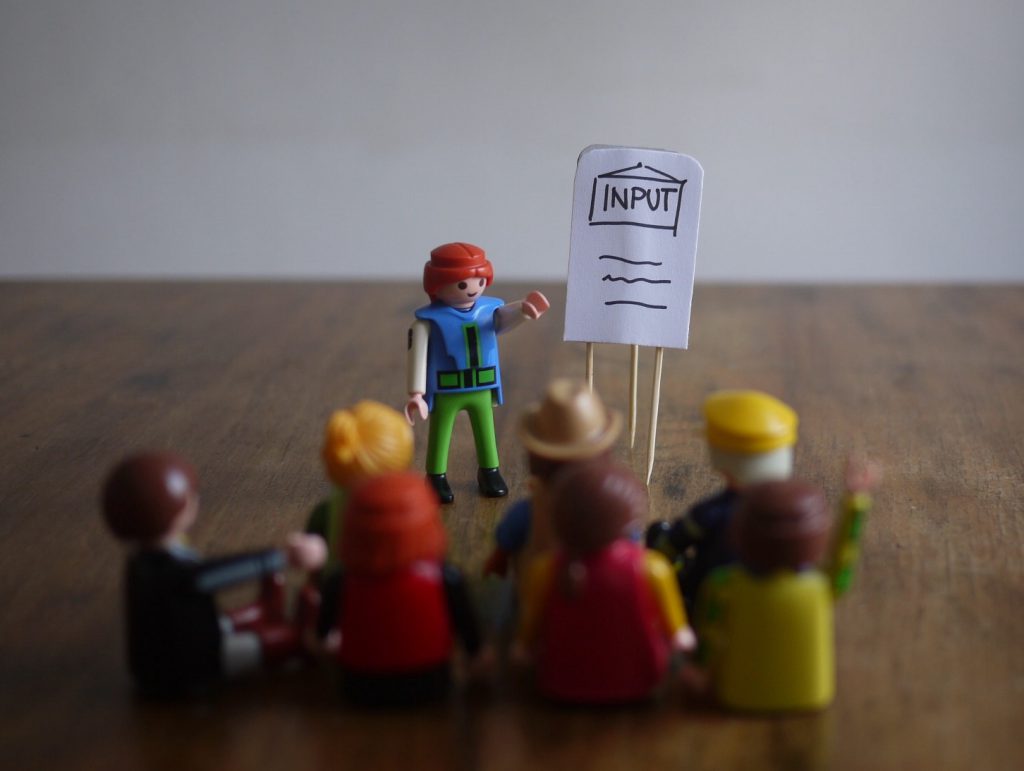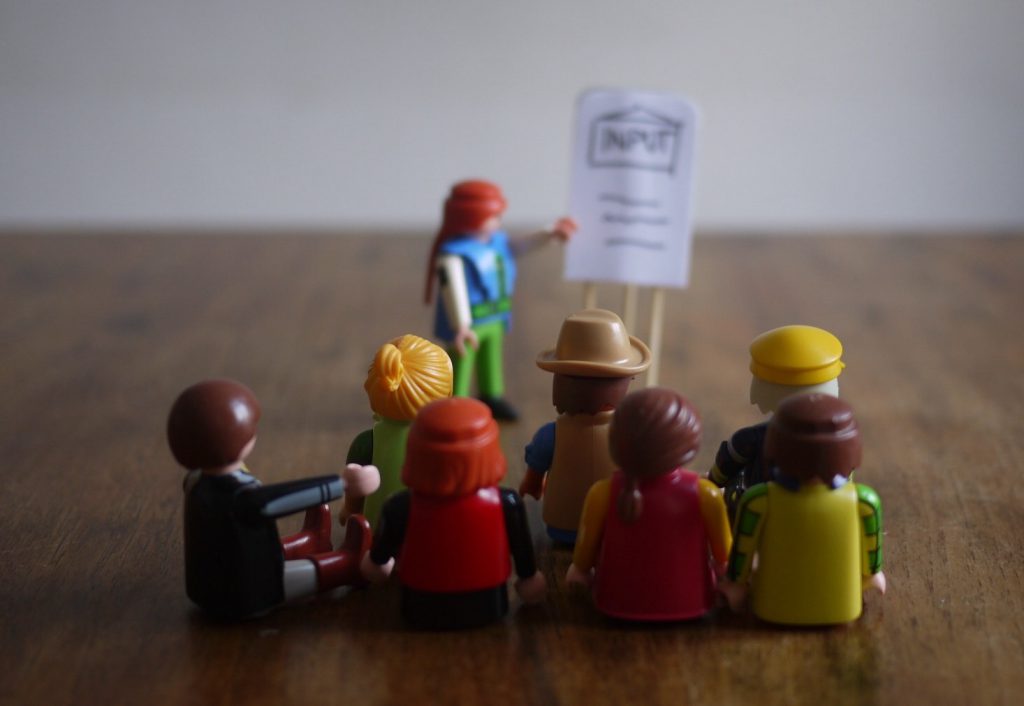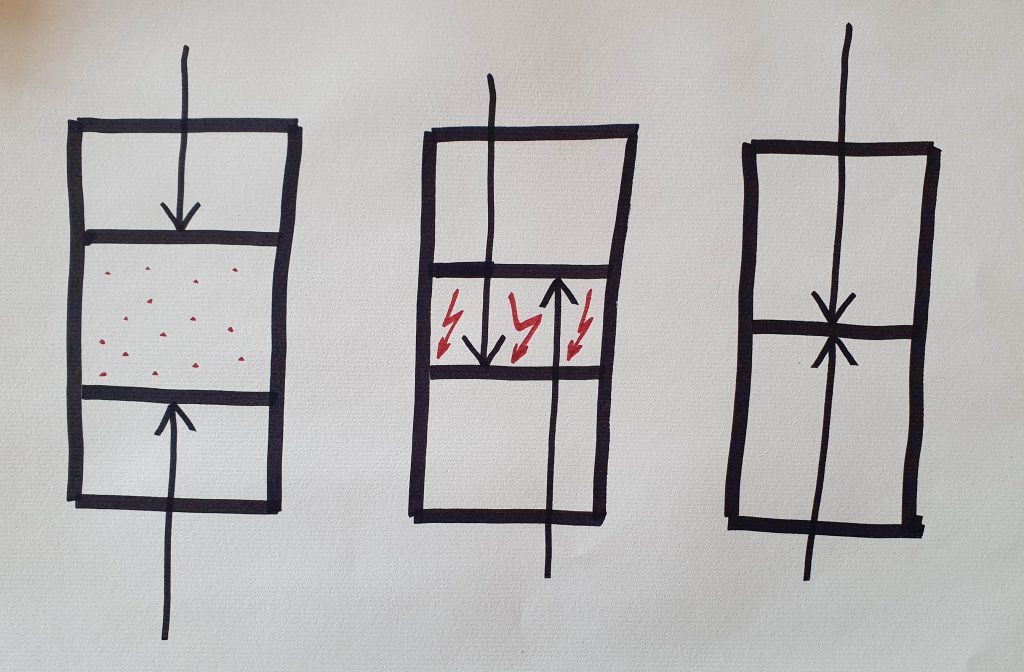My role as trainer
In this part we think about our role as trainers. Beate has been asked to lead a seminar for managers who work a lot with project groups. She uses our case group to test the structure of her seminar. In doing so, she deals with questions like „What is too much control? Where is the border to complete laissez-faire and how much should trainers get involved at all?“
Welcome to grumo_#4!
Beate is noticeably nervous as the others arrive. She sorts through her documents for the umpteenth time and makes sure she has all the papers. Performing in front of colleagues is something quite unique. The others know this, of course, and soon the initial chit-chat dies down and everyone eagerly looks at Beate. She clears her throat: „Thank you for taking the time to give me feedback today. I’ll outline again very briefly what this is about for me.“ The group she has asked are middle management people who run a department or project group. They want to encourage their people to get involved and at the same time they can’t quite let go of the helm. „I basically want to introduce them to a governance model of groups and talk about the role of leadership.“ Beate picks out the two relevant handouts. „Feel free to ask when something is unclear in between. At the very end, I would also like feedback on the overall package and my appearance.“ The others nod and Beate gets started.
Over-control
„The function of the leader is similar to that of the trainer in a seminar: to provide structure and take responsibility! What do I mean by responsibility? Ultimately, you are the decision-makers: The project leader takes responsibility toward the next level of management, the trainer takes ultimate responsibility for the design of the seminar, the breaks, the end, the next steps. Like this. Now, of course, this can happen more or less in consultation and coordination with the group. If the leader specifies a lot, then that can be very pleasant for a group, especially at the beginning: agreements are made (see Grumo #3) and the framework is set out in which participation is possible.“
Beate interrupts briefly: „At this point I would remind the participants again of the clarification of expectations and the clarification of the way of working that happened just before in the seminar. You just have to imagine them now.“ The others nod, Beate smiles, takes up her posture again and continues with her explanation: „If the leadership continues to permanently give instructions, although the participation of the participants was actually agreed, then it can easily lead to over-control. Over-control becomes visible, for example, in the expression of dissatisfaction, refusal to work, disinterest, resistance, co-referenda, etc. It makes it seem as if the leader is constantly giving instructions. It creates the impression that something is wrong.“ Beate nods at Paul, who smiles knowingly – because at the last meeting he had brought a case in this regard.
Under-control
„If the leader takes little or no responsibility, but leaves everything to the participants, this can lead to under-control and also to disturbances. The visible effects here are, for example, demotivation, paralysis, insecurity and conflicts among each other. In both cases it can happen that the leader is removed and someone from the group takes over. You’re probably familiar with this from one work context or another, when a leader doesn’t take on their responsibility and it’s actually someone else from the department or – a classic – the long-serving secretary who directs the business.“
Beate passes out the first handout explaining over-control and under-control again. „At different stages, a group needs more or less control. This is not something that is permanently fixed, but depends on the task, how long the group has known each other and worked together, and of course the personalities involved. Feedback and satisfaction surveys (how-are-you rounds) can help to quickly get a good impression of the needs in the group. This makes the role of the leader challenging, because in addition to controlling the content, you should also keep an eye on the group process in order to decide how much intervention is necessary.“
Role of the trainer, role of the leader
„You see, there are many parallels between my role here as a trainer in the seminar and the demands on you as a leader of a department or project group. So, if you are looking for ideas, you can look at trainers or leaders that you have already experienced in your career and learn something or other from them – both in a positive and negative sense. Yes please?“ – Rudi spoke up. „I’m asking this now as an interested participant: how would you deal with mistakes?“ „With mistakes I make myself?“ asks Beate. Rudi nods. „Thank you, that’s an exciting question. Personally, I have quite an open error culture: if I make a wrong turn, I correct the course and also tell the participants or staff. If it’s a small mistake, it’s usually not even noticed, then I don’t harp on it for long, if it was a more fundamental misjudgement, then everyone has probably already noticed it anyway, then you can address it right away as well!“ laughs Beate.
„As a leader, the focus is not on you as a person, but on the function you hold. And the function has to separate itself from its sensitivities to a certain extent, because these are not helpful for the progress of the project. This separation is often not so easy. That’s probably why some managers are so extremely detached, because for them it’s the only way to separate function and person. For me, I have found a very good mixture that I feel comfortable with, but there is still no place for very personal and private matters in my role as leader. It’s a tightrope walk that doesn’t get easier the longer you accompany a group. Each person has to find a good balance. In case of doubt, feedback from colleagues is also helpful.“ Beate brushes her hair out of her face. The second handout is a worksheet on which the participants are asked to reflect on their own handling of demarcation between function and person on the basis of role models.

Feedback
Beate leans back. „So, that would be roughly my plan. Oh yes, the handout will first be discussed in small groups and then in plenary. After that I have planned some time for questions and feedback. But now I’m looking forward to your feedback!“ says Beate and looks expectantly at the group. Most of them are still reading through the handout, Paul is taking a few notes. „What I liked most was that you made such a good, immediate connection to the seminar. That makes it so practical!“ says Maria. Paul nods: „I really like your inputs. Not too much theory, something practical to apply and then something to think about on an individual level. Very well structured.“ The others are also impressed by Beate’s input. Yasemine adds: „I can really take something away with me. In such cases, I usually come up with too detailed theories on group dynamics or something. People find it interesting, but sometimes not practical enough. I’ll be happy to take something from it for my next input on the topic.“
„Shall we look at group phases next time?“ Paul asks the group, „they would fit well now, I think.“ No one seems to object. So Paul agrees to take the lead.
Authors: Gerda Kolb and Irene Zavarsky
Lust auf mehr? Zu allen Beiträgen der Serie kommst du HIER!

Dieses Werk ist lizenziert unter einer Creative Commons Namensnennung-NichtKommerziell-Weitergabe unter gleichen Bedingungen unter gleichen Bedingungen 3.0 Österreich Lizenz.
Volltext der Lizenz



